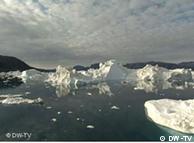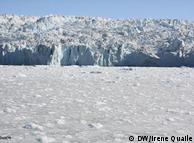Arctic melts faster than IPCC's forecasts
When the last Intergovernmental Panel on Climate Change (IPCC) report was published in 2007, there was a lack of data on the Arctic, so the panel left a big source of potential sea-level-rise out of its projections for this century.
It estimated a conservative rise of about 18-59 centimeters. Many scientists have suspected that the IPCC's projections underestimate the pace of change and the latest research appears to back them up. [New estimates are about 1.0-1.5 m.]
Unprecedented Arctic ice melt Sea levels are rising faster than IPCC predictions
Sea levels are rising faster than IPCC predictions
 Sea levels are rising faster than IPCC predictions
Sea levels are rising faster than IPCC predictionsNew findings by the Arctic Monitoring and Assessment Programme (AMAP), a working group of the Arctic Council, reveal unprecedented rates of change in the Arctic Ocean, the mass of the Greenland ice sheet and the region's ice caps and glaciers over the past ten years.
The research confirms that warming in the Arctic has been occurring at twice the global average warming trend since 1980.
Surface air temperatures in the Arctic since 2005 have been higher than for any five-year period since measurements began around 1880, and summer temperatures in the region have been higher in the past few decades than at any time in the past 2,000 years.
Although there is a very high degree of variability in the state of sea ice from year to year,
Sebastian Gerland – one of the report's contributors from the Norwegian Polar Institute in Tromsö – says long-term monitoring at various points in different Arctic regions shows clear trends: Too little ice, shorter winter seasons when freezing takes place and an early onset of spring and summer melting.
"The clarity of that trend is very striking," says the sea ice expert. Indeed, during the last five years, sea ice in the Arctic summer has retreated to its lowest levels since satellite measurements began in 1979.
Gerland stresses that sea ice in the Arctic is not just of local importance. As well as its influence on the ecosystem in the Arctic, it also actively influences the global climate. The white ice floating on top reflects solar radiation back up into the atmosphere. Without it, the heat is absorbed by the dark ocean.
Feedback loops
This feedback effect had been anticipated by climate scientists, but clear evidence that a warmer climate has in turn intensified the warming trend has only been observed in the Arctic in the past five years.
 Some 85% of Greenland is covered in ice
Some 85% of Greenland is covered in iceAnother of these feedbacks referenced in the AMAP report is melting permafrost.
The permafrost stores large amounts of methane, which is around 20 times more potent than carbon dioxide (CO2) as a greenhouse gas.
The report indicates that melting permafrost areas can potentially release large amounts of stored methane, as well as CO2, into the atmosphere.
Volker Rachold, Executive Secretary of the International Arctic Science Committee, based in Germany, warns this process could in turn further influence the climate beyond humans' control.
Greenland: Crucial to global sea-level
The third set of significant findings in the Arctic survey relates to the Greenland ice sheet, the largest area of freshwater ice in the northern hemisphere, which is of key importance to global sea levels.
Rachold says the new body of research findings suggest the cautious figures for sea level rise contained in the last IPCC report underestimate the trend.
"The latest figures show very clearly that the sea level rise we can expect by 2100 will be much higher than predicted. This is connected to the fact that the Greenland ice sheet is currently melting at a very fast rate."
A significant finding, says Professor Wolfgang Lucht from the Potsdam Institute for Climate Impact Research.
"If a certain temperature threshold is crossed, the melting of Greenland cannot be stopped any more," Lucht says.
The problem is that scientists do not yet know what that temperature threshold would be, and just how fast the ice would melt once a "tipping point" has been reached.
"Recent research seems to indicate it is lower than we thought. We thought it was around 3 degrees (Celsius) of warming – and it's quite likely we might reach 3 degrees. New research seems to suggest it is actually lower and it would actually be crossed at 2 degrees."
Dwindling hopes for the 2 degree target
There is still a lot of uncertainty surrounding estimates of future sea-levels.
The new report by the (AMAP) projects sea levels to rise by between 0.9 and 1.6 meters by the end of the century – significantly more than the IPCC's 2007 projections.
If the Greenland ice sheet were to melt completely, which would take several hundred years, sea level could rise by 7 meters – more than enough to inundate many of the world's coastal megacities.
The key question is whether it will be possible to limit warming to 2 degrees Celsius – a target which might be enough to keep the Greenland ice sheet more or less intact.
Although the world has agreed to strive for the 2 degree target, experts like Peter Lemke, head of the climate section at Germany's Alfred Wegener Institute for Polar and Marine Research, say current pledges to reduce emissions are not nearly enough.
He points to the rise in CO2 emissions in the last year as economies picked up after the financial crisis.
"Emissions are now running right on the line of the worst scenario the IPCC is calculating. So in the long run this would mean a 4 degree, or even higher, increase of temperature by the end of the century."
To keep to the 2 degree target, emissions would have to peak in the next 10 years and be reduced by 80% by 2050, according to these scientific experts.
The window of opportunity is rapidly closing, while the ice of Greenland flows ever faster into the ocean.
Author: Irene Quaile
Editor: Nathan Witkop
Editor: Nathan Witkop









No comments:
Post a Comment